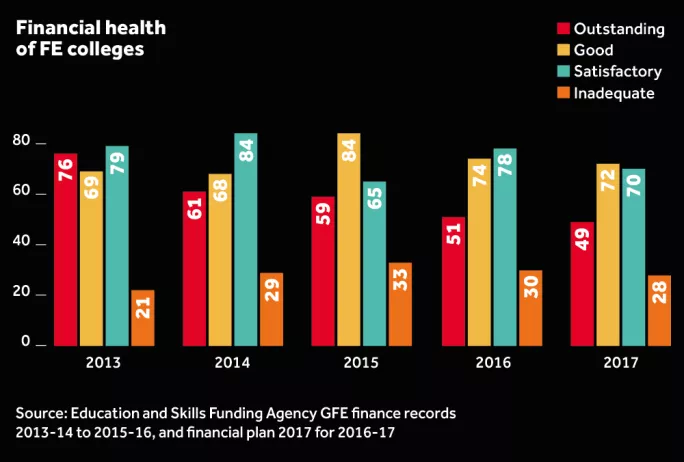Further education faces a ‘homegrown credit crunch’

The Technical and Further Education Act 2017, one of the last pieces of legislation to be passed ahead of this year’s general election, was intended to create a “clear and well-understood insolvency framework for the benefit of learners, colleges and taxpayers”.
But experts are concerned that the act, together with the area review-led reform of colleges and financial difficulties they face, has meant that banks have largely “walked away” from the sector.
The changes, one college leader warned, have resulted in providers being deemed a “risky proposition”, making it more difficult and more costly for institutions to borrow - and leaving them increasingly reliant on the government for funding.

Ahead of the autumn budget, the Association of Colleges (AoC) warned that colleges were facing a “homegrown credit crunch”, with total borrowing having dropped from £1.6 billion in 2014 to £1.3 billion this summer - and signs suggesting it is “falling further”.
It pointed out that the main two lenders - Barclays and Lloyds, which in 2014 accounted for 90 per cent of college loans - were “taking steps to reduce their exposure”, while Santander was offering “very limited” new lending. This, the report said, had led to “higher interest margins and tougher covenants”.
Banks are ‘even more nervous’
Julian Gravatt, AoC deputy chief executive, says the prospect of the new insolvency regime has “made the banks even more nervous”, resulting in colleges increasingly relying on the government as the “lender of last resort”.
“What we have had is a significant cut in new capital expenditure, because all the people that used to fund capital expenditure [both government and the banks] have stopped doing that,” says Gravatt.
Several sources have told Tes that college mergers have faced lengthy delays and disruptions as a result of banks looking to change terms and conditions for loans.
“Banks now have to make more profit...so they might be trying to get out of their college loans and charge more,” Gravatt says.
In August, East Coast College was created from a merger between Great Yarmouth and Lowestoft colleges. Principal Stuart Rimmer says that while the bank behind the new college had been “incredibly supportive”, elsewhere banks were “feeling exposed to a lot of debt in the sector”.
“The FE sector is increasingly seen as a risky proposition,” he adds. “That is also reflected in terms of securities taken and covenants set within any loan. We saw a change in conditions: there was a much greater focus, rather than on overall levels of borrowing, on debt serviceability and cash generation.”
Another college principal, who asked not to be named, says he is aware banks are considering factors such as recent Ofsted reports when making decisions on lending.
In June, Newham Sixth Form College opened a £10 million new facility at its East London site. This was part-financed through a commercial loan - the first in the college’s history, according to principal Eddie Playfair.
“This represents a prudent level of borrowing on the basis that we feel we can afford the repayments and are not planning to be in deficit on our revenue budget.”
A spokesman for Lloyds Banking Group says it is “continuing to support the sector through our existing lending commitments”.
A Barclays spokesman says it “continues to be a significant long-term supporter of the further education sector, providing funding and relationship banking to almost half of the country’s colleges.”
And a spokeswoman for Santander says that it has not “made any changes to the terms of the loans with FE colleges since we first started lending to them in 2008”, and is “still active in this space”.
You need a Tes subscription to read this article
Subscribe now to read this article and get other subscriber-only content:
- Unlimited access to all Tes magazine content
- Exclusive subscriber-only stories
- Award-winning email newsletters
Already a subscriber? Log in
You need a subscription to read this article
Subscribe now to read this article and get other subscriber-only content, including:
- Unlimited access to all Tes magazine content
- Exclusive subscriber-only stories
- Award-winning email newsletters